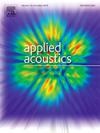Broadband sound absorption and slow wave in truncated sonic black hole
IF 3.4
2区 物理与天体物理
Q1 ACOUSTICS
引用次数: 0
Abstract
The sonic black hole (SBH) exhibits significant potential for trapping and dissipating acoustic waves. In this article, we propose a truncated-tail SBH (TSBH) composed of 20-unit cells, with heights increasing according to an exponential law. The truncated-tail SBH enhances low-frequency absorption peaks below the first-order cut-on frequency by promoting global resonance along the entire length of the structure. This results in an expansion of the sound absorption bandwidth towards lower frequencies, while maintaining the overall structural length. At low frequencies, the high-quality factors of resonance impede the formation of broadband sound absorption peaks. To address this, porous materials are integrated into the unit cells, effectively mitigating the inherent radiation leakage at frequency below 850 Hz. This approach significantly enhances sound absorption in the low-frequency range, ensuring better energy dissipation and addressing the challenges posed by strong dispersion effects in this regime. Slow wave phenomena are also observed in the same frequency range by calculating the effective bulk modulus and sound speed. Test samples are manufactured using 3D printing and tested in a square cross-section impedance tube. An average sound absorption coefficient greater than 80 % is measured over a broadband range from 250 to 1700 Hz with a structure thickness of 100 mm. The proposed slow sound theory and the properties of truncated SBH with added porous materials may pave the way for perfectly absorbing SBH, potentially broadening its application.
求助全文
约1分钟内获得全文
求助全文
来源期刊

Applied Acoustics
物理-声学
CiteScore
7.40
自引率
11.80%
发文量
618
审稿时长
7.5 months
期刊介绍:
Since its launch in 1968, Applied Acoustics has been publishing high quality research papers providing state-of-the-art coverage of research findings for engineers and scientists involved in applications of acoustics in the widest sense.
Applied Acoustics looks not only at recent developments in the understanding of acoustics but also at ways of exploiting that understanding. The Journal aims to encourage the exchange of practical experience through publication and in so doing creates a fund of technological information that can be used for solving related problems. The presentation of information in graphical or tabular form is especially encouraged. If a report of a mathematical development is a necessary part of a paper it is important to ensure that it is there only as an integral part of a practical solution to a problem and is supported by data. Applied Acoustics encourages the exchange of practical experience in the following ways: • Complete Papers • Short Technical Notes • Review Articles; and thereby provides a wealth of technological information that can be used to solve related problems.
Manuscripts that address all fields of applications of acoustics ranging from medicine and NDT to the environment and buildings are welcome.
 求助内容:
求助内容: 应助结果提醒方式:
应助结果提醒方式:


